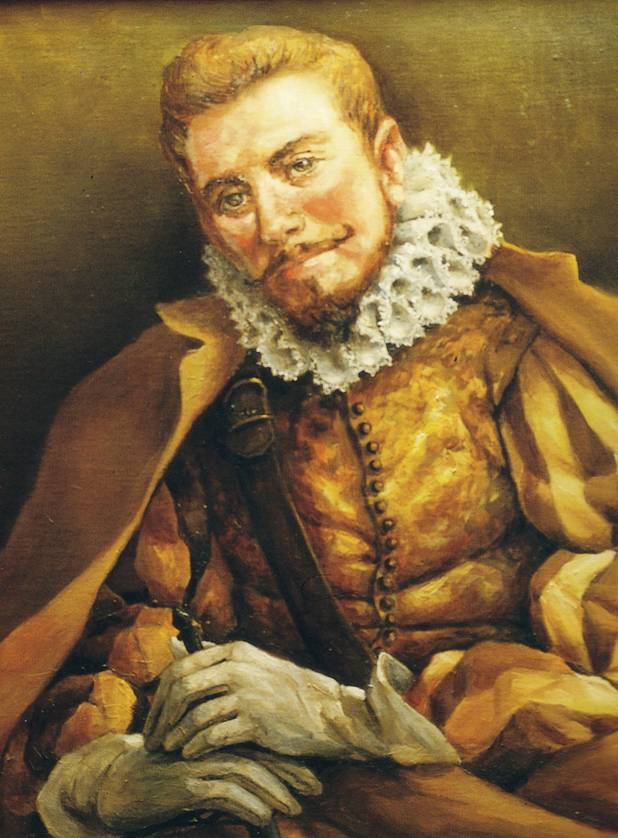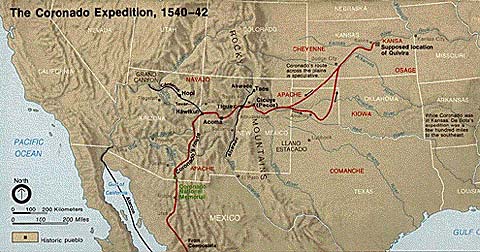Francisco Coronado was a Spanish conquistador who explored the southwestern part of the United States in search of the Seven Cities of Gold.

There are many interesting Francisco Coronado facts about his travels. He ventured into what is now modern-day New Mexico and Arizona and interacted with several Southwest Indian Tribes. He had a little lasting impact on the New World and retired in bankruptcy.
Jump to:
Francisco Coronado Facts: Early Life
Francisco Coronado was born to Juan Vasquez de Coronado and Isabel de Lujan.
Juan served in the government of Granada, which had been conquered by Ferdinand of Aragon and was the last stronghold of the Moors. Coronado undoubtedly grew up in a wealthy family and was educated in the finest of schools.
Coronado was born in 1510, just 18 years after Christopher Columbus had discovered the new world.
Coronado undoubtedly grew up hearing stories of Columbus' exploits and of the vast wealth acquired by men such as the Portuguese explorer Vasco da Gama and the Spanish conquistadors Vasco Balboa, Hernan Cortes, and Francisco Pizzaro.
Each man had great success in the New World (although Balboa was executed, which was more of a political dispute) and established their names on the pages of history. At the young age of 25, Coronado traveled to the Americas, where he sought to establish his own legacy.
Francisco Coronado Facts: Americas and Ambitions
Coronado arrived in the New World with Antonio de Mendoza, a son of his father's patron who had died. While in Mexico, he found a wife and inherited a large estate.
He and his wife, Beatriz de Estrada, had eight kids together and, from all accounts, had a good marriage. Coronado began to rise through the ranks quickly and led an expedition that conquered the Kingdom of Nueva Galicia.
After its conquest, Coronado learned from a scout that he had sent out of a golden city called Cibola. This mythical city would become his obsession and would also be his undoing.
He did not need any additional money, but his ambition for power and riches consumed him. His friend Antonio de Mendoza sponsored Coronado's expedition, and Coronado himself pawned his wife's estate to fund the expedition. Mendoza named Coronado as the commander with a mission to find and plunder the seven golden cities of Cibola.
Francisco Coronado Facts: Cíbola Conquest and Other Discoveries
Coronado traveled along what is now modern-day New Mexico and Arizona until he came to the Zuni River. He continued to travel with the river until he found the Zunis. Contrary to what was believed, the Zunis were not wealthy people.
With members of his expedition starving and the Zunis refusing to allow the Spanish entrance into their village, Coronado engaged in what became known as the "Conquest of Cibola."
During the battle, the Spanish took control of the Zuni village, but Coronado was wounded and would be required to stay with the Zuni people until he was healed. During this time, he sent out several scouting parties to find the cities of gold. When he had healed he planned to resume his expedition. Here is a summary of some of the expeditions:
- Pedro de Tovar led the first expedition and headed northwest to the Hopi villages. Once again, the Spanish were denied entrance into the village and had to use force to enter. The Hopi region once again yielded disappointment as there were no riches to be found. The only positive result of the expedition was the discovery of the large Colorado River.
- Garcia Lopez de Cardenas led the second expedition. This expedition found Colorado and followed it to the Grand Canyon. This would mark the first Europeans to see the Grand Canyon.
- Hernando de Alvarado traveled east around the Rio Grande River. Here, he found several villages. Coronado had recovered from his injury and set up his winter quarters in the village of Tiguex. A conflict broke out, which became known as the Tiguex War. The Spanish easily beat the Tiguex people and killed hundreds of them.

Francisco Coronado Facts: The Search for Quivira and Legacy
After the Conquest of Cibola, Coronado saw little success. He was determined to find the seven cities of gold and heard from an Indian guide that the Spanish dubbed "the Turk" of a wealthy civilization called the Quivira located in the far east of the New World. While his intentions are unknown, it is believed that the Turk deceived Coronado and his men. His trail came nowhere close to the Quivira. Coronado's expedition would soon become a reconnaissance mission instead of a quest for gold.
Along the trail that the Turk led Coronado and his men, the great Spanish Conquistador came across many different tribes and peoples. Most of these people were buffalo hunters and nomads, but some, such as the Apache, were and would become large tribes that would survive until the United States expansion.
Coronado noted in his journal all the buffalo, which he called cows, and how numerous the bison were. While they were numerous in the 16th century, the bison would almost become extinct during the 19th century.
One of the more interesting encounters that Coronado had with one of the nomadic Indian tribes was with an old blind man from the Teyan tribe. He noted in his journal that this Indian elder had met "four others like us."
As Tony Horwitz noted in his book A Voyage Long and Strange: On the Trail of Vikings, Conquistadors, Lost Colonists, and Other Adventurers in Early America, this was probably a reference to the epic journey of Cabeza de Vaca about 10 years before Francisco Coronado.
The Teyas alerted Coronado to the actual location of the Quivira people and told him that they were to the north. Coronado followed their advice and managed to find the wealthy civilization that he had been told about. However, the Quivira were not wealthy and were referred to as simple people with a fine build.
The men were tall and notably strong and agile. He questioned the Quivira people to find a wealthy civilization. They told him of the Harahay people. Upon finding the Harahays, Coronado noted in his journal, "all naked, with bows, and some sort of things on their heads, and their privy parts slightly covered."
Coronado never found the treasure he was looking for. He began a journey back home, but before he did, he had "the Turk" garroted.
After a fall from his horse that left him injured, Coronado was convinced to return home. His expedition was a failure, and his money was depleted. Coronado became the governor of Nueva Galicia. His governorship lasted until 1544, when bankruptcy forced him into private life. He lived another decade and then died on July 21, 1554.
Coronado left a sad legacy. A man that had more than most, but his greed led him to try to trace a mythical land. The myth cost him his health, money, and prestige. He left little impact on the places he visited.
